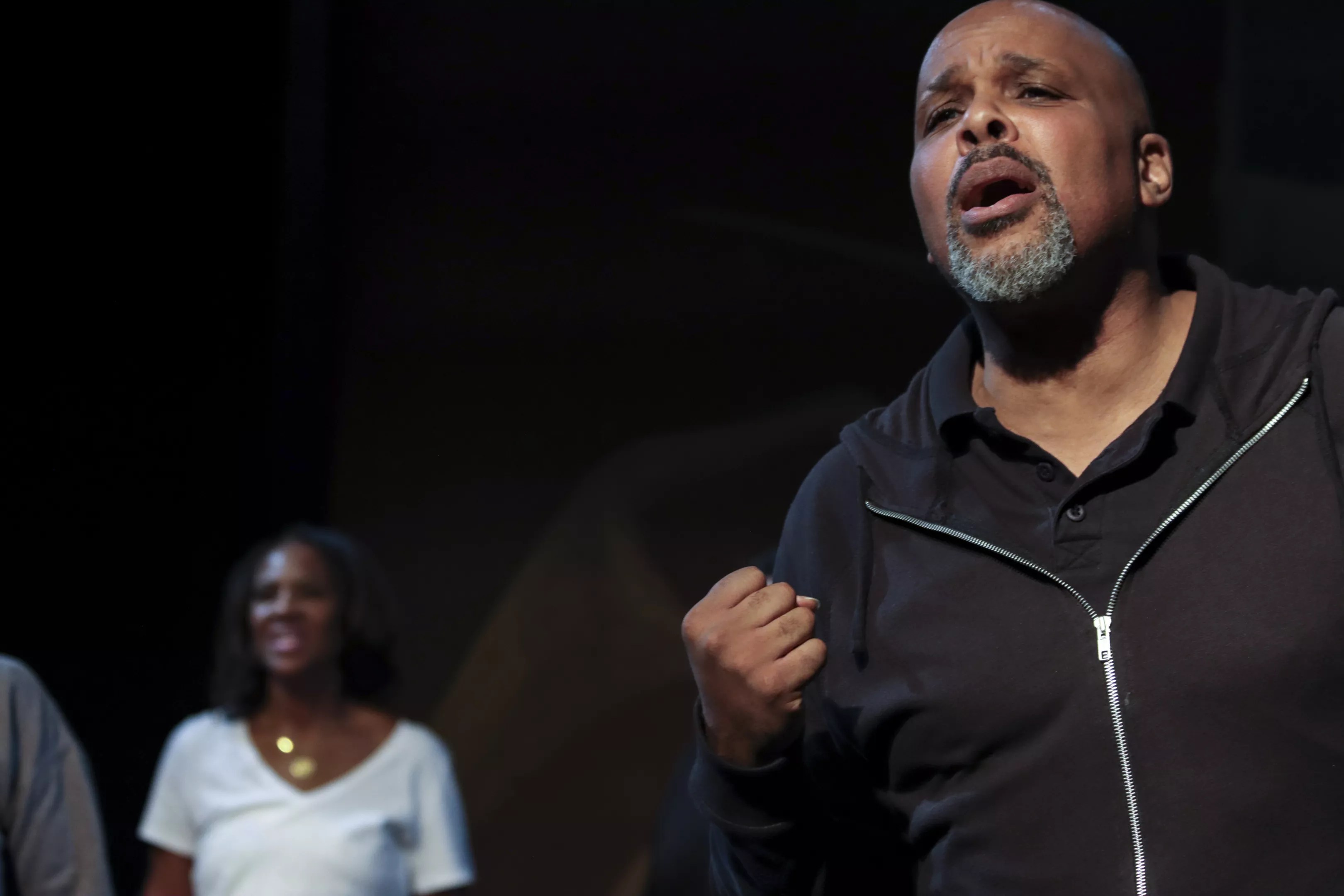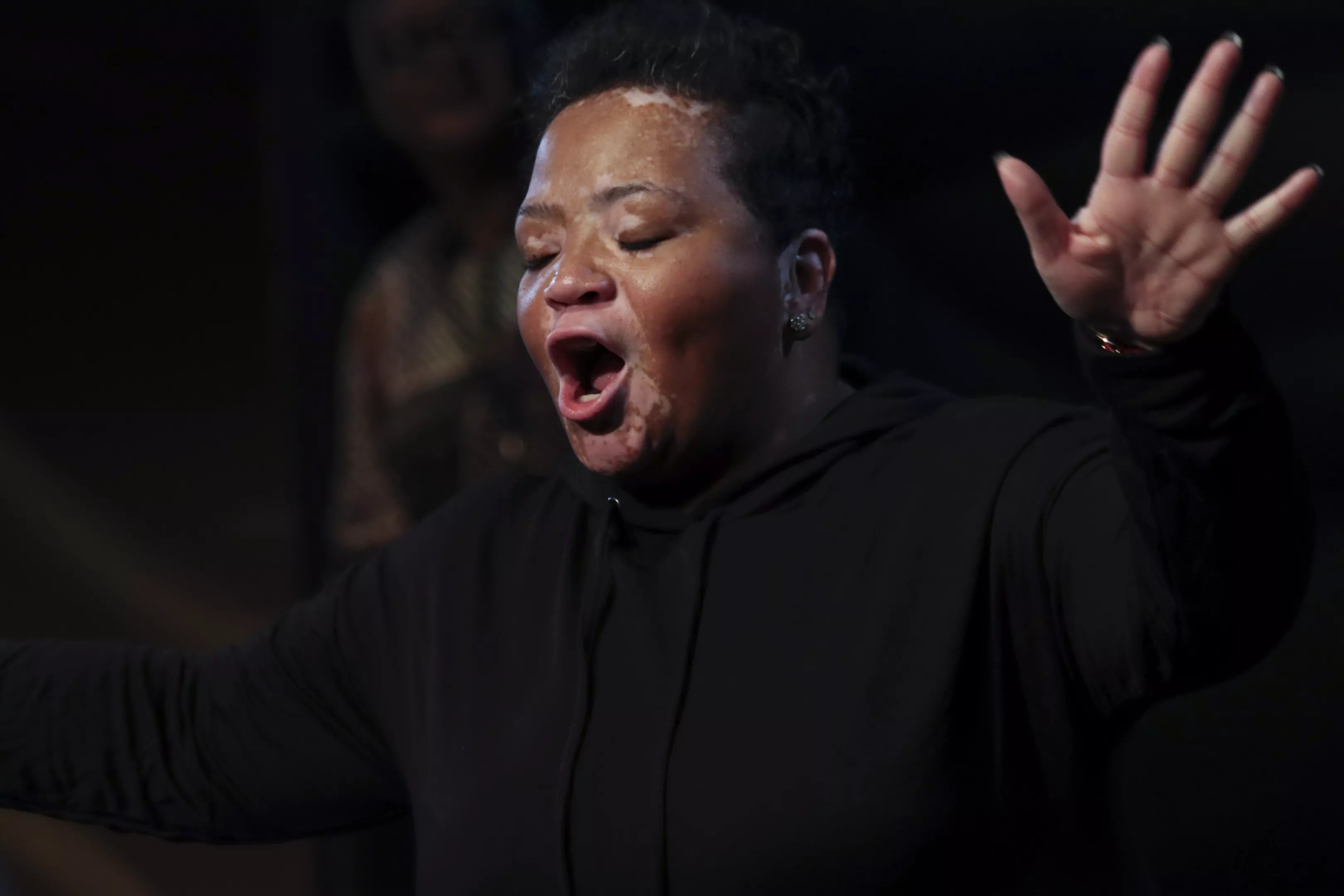
Courtesy of Margaret Norwood

Audio By Carbonatix
Jo Bunton Keel knows Black Nativity like the rhythm of her heartbeat. With Denver’s Eulipions Theatre, a now-dormant organization she co-founded with Jimmy Walker in 1982, Bunton Keel brought Langston Hughes’s gospel-infused masterpiece to life seventeen times, becoming synonymous with the city’s joyful retelling of Black Nativity.
This year, she is reclaiming that legacy with Vintage Theatre‘s daring revival, determined to restore faith in the production after the company’s revival last year failed. “I did this with Vintage because, I hate to say this word, but I wanted to reincarnate the integrity of Black Nativity,” Bunton Keel says, adding that “2004 in Montbello was the last time Eulipions did Black Nativity, so it’s been twenty years. Black Nativity has always been a joyous occasion, and I believe it is a story that we need now.”
Written by Hughes in 1961, Black Nativity tells the story of Jesus’s birth through the lens of the African American experience, combining gospel music, African rhythms and spoken word with a biblical and deeply human narrative.
“We are telling the story, not a story,” says music director Minister Daryl Walker. “We’re saying Bethlehem is not in Colorado Springs; it’s in Africa. Somebody could talk about it in Colorado Springs, but that’s just a story; we’re saying this story is the absolute truth we’re speaking to.”
We’re thankful for you. Are you thankful for us?
We feel thankful for our staff and for the privilege of fulfilling our mission to be an unparalleled source of information and insight in Denver. We’re aiming to raise $50,000 by December 31, so we can continue covering what matters most to this community.
Help us continue giving back to Denver.
“Bethlehem and Jerusalem are in the cradle of civilization in Africa,” Bunton Keel adds. “The person we know as Jesus is not Anglo-Saxon. If anything, he is Eritrean or Ethiopian, but he is African. The reason that Langston Hughes wrote this, going into the civil rights movement, is for us to remember our roots in spirituality.”

“Black Nativity has always been a joyous occasion, and I believe it is a story that we need now,” says director Jo Bunton Keel.
Courtesy of Margaret Norwood
The production unfolds in two acts. The first focuses on the journey of Mary and Joseph as they search for a place to bring Jesus into the world. “We begin with ‘The Creation,’ by James Weldon Johnson, setting the stage for the church as the universe – God’s creation of trees, grass, rivers and humanity itself,” Bunton Keel explains. “Then we move into the village, where Mary and Joseph can’t find a place to stay. It’s like a modern-day convention where every hotel is booked. This woman is ready to have a baby, and there’s nowhere for them to go.”
Act Two shifts to a celebration of African American church traditions. “The second act is about communication and renewal,” says Bunton Keel. “It also symbolizes the transfer of culture into the Black Baptist Church, with scenes like a baptism in rivers rather than sanctuaries. That immersion goes back to where Jesus was baptized – by John the Baptist in a river.”
Choreographer Janice Guy-Sayles, who considers Bunton Keel her mentor, shared how movement plays a pivotal role in bringing these themes to life. “In Act Two, we include a piece called ‘Closer to You,’ which shows a couple reconnecting after struggles in their relationship,” she explains. “It’s about understanding, forgiveness and healing. Another sequence, ‘Take Me to the Alley,’ is a duet for Joseph that symbolizes him finding guidance and hope through Spirit.
“The first act is pretty much the Nativity scene, but the second act always has had variations depending on what story and themes the director wants to focus on,” Guy-Sayles continues. “I like how we take it to a classic church at the beginning of the second act, then to the baptismal to create a sense of the old-time church.”

“We are telling the story, not a story,” says music director Minister Daryl Walker.
Courtesy of Margaret Norwood
Vintage Theatre’s revival of Black Nativity comes just one year after a failed attempt left the organization financially and emotionally bruised. The 2023 production was canceled just days before opening owing to a combination of internal conflicts, including the dismissal of the director and logistical challenges during rehearsals. The cancellation resulted in a $40,000 loss and was the only production at the time that was canceled after beginning rehearsals.
For Bunton Keel and her creative team, however, the circumstances of last year’s production weren’t a factor.
“It doesn’t have anything to do with whatever happened, because I don’t know,” says Guy-Sayles. “When Jo reached out to me, I wanted to do it because her presence is so strong and important. I’m a part of this because Jo is my mentor and because she established this tradition. I’ve only performed in this one time, but I felt so strongly about doing it again when Jo got it back.”

Act one of Black Nativity tells the story of Jesus’s birth, while Act Two is up to the director’s interpretation.
Courtesy of Margaret Norwood
Stage manager Roslyn Washington, who worked on every Black Nativity produced by Eulipions, shared a similar sentiment.
“I’m doing it for the same reason: This is love,” Washington says. “We had actually been talking to Jo for quite a long time and were really serious about wanting her to come back and do Black Nativity again. We said to Jo, ‘If you decide to do this, people are going to come out of the woodwork, because that’s the level of respect you have,’ and that’s exactly what happened with the cast and what’s going to happen with the audience. We also hope and believe that we can reach a whole new audience, this next generation, but the level of respect that this woman right here has is the reason a lot of people are on that stage right now.”
At the heart of Black Nativity is its music – a soul-stirring blend of gospel and spirituals that carries the audience through the story. “Black Nativity could not exist without the music, and that’s a fact,” Bunton Keel says.
“The music is the fabric that weaves the message together,” Walker adds. “It’s not just about the melodies – it’s about storytelling and ministry. Black Nativity creates a worship environment. There’s a difference between performing and what I call ministry. My work is always in the church. Jo said when we first did something, ‘You can still do this in the theater.’ So there are times and moments in Black Nativity where the spirit is evoked, so this becomes church and the people become the congregation.”

At the heart of Black Nativity is its music — a soul-stirring blend of gospel and spirituals that carries the audience through the story.
Courtesy of Margaret Norwood
Bunton Keel and her team view Black Nativity as a call to action and an invitation to connect with something deeper.
“We as a people have always lived in community,” Walker says. “This is what we thrive on. I am because you are – ubuntu. We are this village, meaning the village is looking out for us at all times. The village is where we want to leave the people, meaning in a place of community, where the community has the power to transform, heal us, nurture us, sustain us and become life-giving and liberating.”
Washington describes how the philosophy of Black Nativity extends to the production process, with the cast and crew sharing a sense of mutual respect and purpose.
“That is why when we circle up, most theater companies say ‘Break a leg,’ but we say ‘Build a spirit,’ because that takes us somewhere totally different,” Washington says. “It’s not about hoping nothing happens to you; it’s about internally feeling something that takes us to where we need to be on stage. It’s not about the show; it’s about how we feel, why we are doing this, and who we are doing it for. How do we do what we’re doing? We feel the spirit.”
This focus on spirit and community is reflected in every element of the production, from its themes of love and healing to its choreography and music. “The synergy we create is healing and hopeful,” Walker says. “We are a circle within the circle, with no beginning and never-ending.”
But the production’s closing scene leaves the audience with a powerful message.
“We end by saying, ‘The world is filled with hate; only love is the cure,'” Walker says. “We all need healing, so you have to swallow your pride so God can heal your heart. It all began over 2,000 years ago, in a stable in Bethlehem, so let’s celebrate and spread the good news. Even though it might be painful, because things are broken, we have to open ourselves up for healing; otherwise, we are just going to stay in the hurt.”
“Black Nativity was written 63 years ago, but it’s still performed throughout the nation for a reason,” Bunton Keel concludes. “It’s not just a play – it’s a tradition of resilience and renewal. And it is not the movie; it is something deeper.”
Black Nativity, Friday, November 29, through Sunday, December 29, Vintage Theatre, 1468 Dayton Street, Aurora. Tickets $24 to $39. Learn more at vintagetheatre.org.